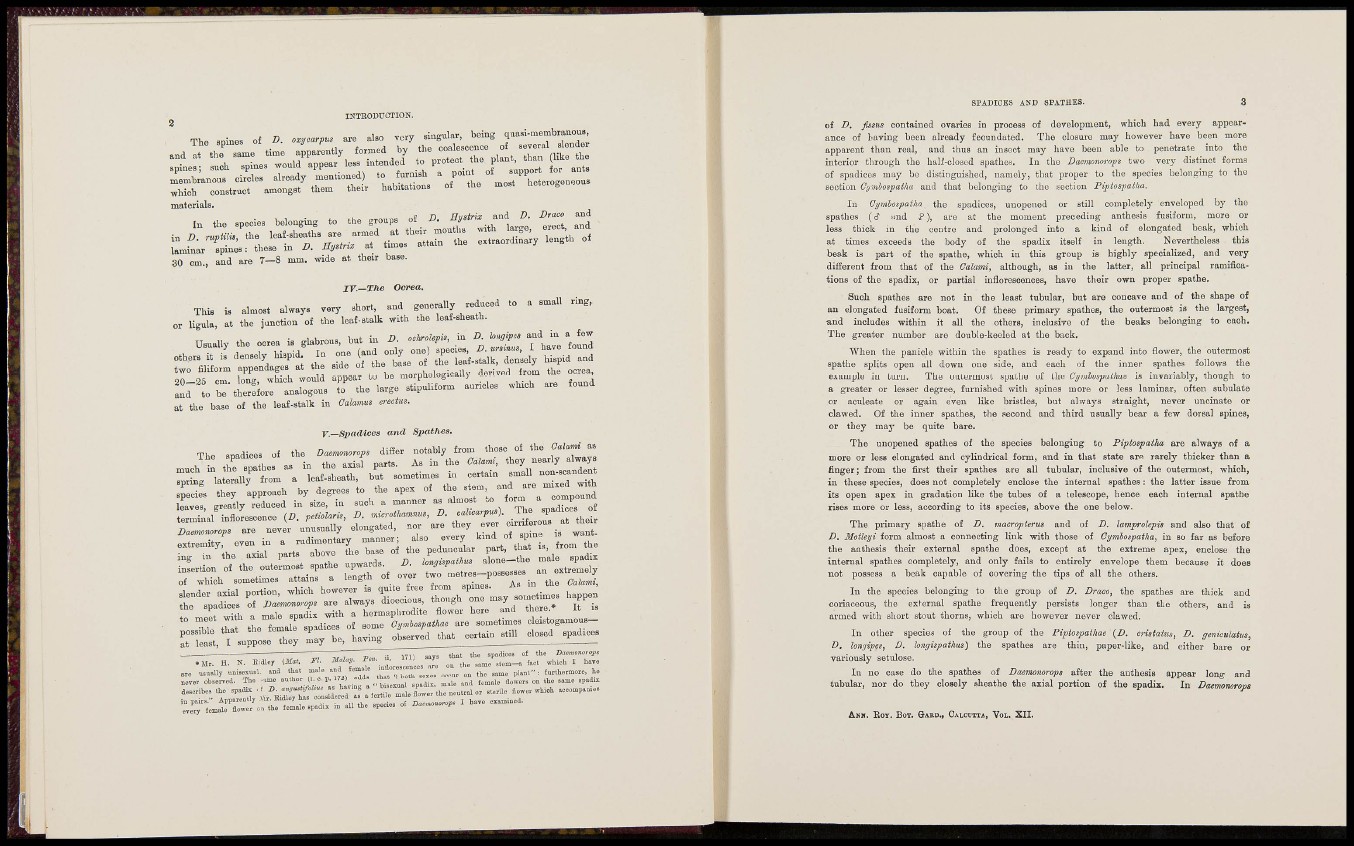
INTBODUCTION.
T h e BDmes of D. mnoarpus are al.o very singular, being pasi-membraneu.,
materials.
I n the specie, belonging to the groups of ^ i ).
80 em., a n d a r e 7 - 8 mm. wide aIVt .-Ithlei eir basOe.o rea.
ring.
This is almost always very short, and gensrally redneed to a
or ligula, at the junction of the leaf-stalk with the leaf-sheath.
at the base of the leaf-stalk in OaUmm motm.
y—Spadices and Spathes.
„f the DaemonoropB differ notably from those of the Oahmi as
t e r m i ^ ^ a M n J e s c e n c e ^D. „tiolarü, B. J^t
„ , «uJlï , — . 1 . »ä 'k" ."4 rrr " ' 0« . l . ..m. furth.^ore, h.
SPADICES AND SPATHBS. 3
of B. fasus contained ovaries in process of development, which bad every appearance
of having been ab-eady fecundated. The closuvo may however have been more
apparent than real, and thus an insect may have been able to penetrate into the
interior tiirough the half-closed spathes. In the Daemonorops two very distinct forms
of spadices may be distinguished, namely, that proper to the species belonging to the
section Cymhosfaiha and that belonging to the section Piptosfatha.
I n Cymbospatha the spadices, unopened or still completely enveloped by the
apathes [S and P), are at the moment preceding anthesis fusiform, more or
less thick m the centre and prolonged into a kind of elongated beak, which
at times exceeds the body of the spadix itself in length. Nevertheless this
beak is part of the spathe, which in this group is highly specialized, and very
difierent fi-om that of the Calami, although, aa in the latter, all principal ramifications
of the spadix, or partial inflorescences, have their own proper spathe.
Such spathes are not in the least tubular, but are concave and of the shape of
an elongated fusiform boat. Of these primary spathes, the outermost is the largest,
a n d includes within it all the others, inclusive of the beaks belonging to each.
The greater number are double-keeled at the back.
When the panicle within the spathes is ready to expand into flower, the outermost
spathe splits open all down one side, and each of the inner spathes follows the
example in tui-n. The outermost spathe of the Cymbospathae is invariably, though to
a greater or lesser degree, furnished with spines more or less laminar, often subulate
or aculeate or again even like bristles, but always straight, never uncinate or
clawed. Of the inner spathes, the second and third usually bear a few dorsal spines,
or they may be quite bare.
The unopened spathes of the species belonging to Piptospatka are always of a
more or less elongated and cylindrical form, and in that state ar« rarely thicker than a
finger; from the first their spathes are all tubular, inclusive of the outermost, which,
i n these species, does not completely enclose the internal spathes : the latter issue from
its open apex in gradation like the tubes of a telescope, hence each internal spathe
rises more or less, according to its species, above the one below.
The primary spathe of D. macropterus and of D. lamprolepia and also that of
D. Motleyi form almost a connecting link with those of Cymbospatha, in so far as before
t h e anthesis their external spathe does, except at the extreme apex, enclose the
internal spathes completely, and only fails to entirely envelope them because it does
not possess a beak capable of covering the tips of all the others.
I n the species belonging to the group of D. Draco, the spathes are thick and
coriaceous, the exfernal spathe frequently persists longer than the others, and is
armed with short stout thorns, which are however never clawed.
I n other species of the group of the Pipiospathae {D. criatatiis, D. geniculatus,
D. longipes, D. longispathus) the spathes are thin, paper-like, and either bare or
variously setulose.
I n no case do the spathes of Daemonorops after the anthesis appear long and
tubular, nor do they closely sheathe the axial portion of the spadix. In Daemonorops
ASM. EOY. BOT. ÖAKD., Calcctta, VOL. XII.